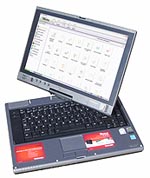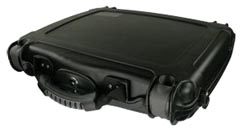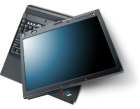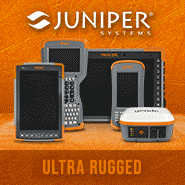November 2006
Full review: Toshiba Tecra M7 Tablet PC convertible Toshiba has along history in pen computers, going all the way back to the early 1990 Dynapad T100 and T200. The company has remained a pioneer in Tablet PCs, and their latest model is the Tecra M7, a replacement for the earlier Tecra M4. Following current trends, the M7 has a (superb) 14.1-inch 1440 x 900 pixel wide screen. It also has all the other trimmings of a modern, powerful, full-function notebook computer. And it is fully Windows Vista Premium Ready. We reviewed the Tecra M7 in detail. [Read Toshiba Tecra M7 review] -- Posted Thursday, November 30, 2006
Toshiba has along history in pen computers, going all the way back to the early 1990 Dynapad T100 and T200. The company has remained a pioneer in Tablet PCs, and their latest model is the Tecra M7, a replacement for the earlier Tecra M4. Following current trends, the M7 has a (superb) 14.1-inch 1440 x 900 pixel wide screen. It also has all the other trimmings of a modern, powerful, full-function notebook computer. And it is fully Windows Vista Premium Ready. We reviewed the Tecra M7 in detail. [Read Toshiba Tecra M7 review] -- Posted Thursday, November 30, 2006
DRS receives $19 million Army order
DRS Technologies has received an order valued at approximately $19 million to provide rugged Appliqué Computer Systems and peripheral equipment for the U.S. Army's Force XXI Battle Command, Brigade and Below (FBCB2) program. Installed on over 40 U.S. Army and Marine Corps vehicle platform types, including wheeled and tracked vehicles, as well as Tactical Operations Centers and other command post platforms, DRS's Appliqué Computer Systems support the Army's Blue Force Tracking requirements, which include beyond line-of-sight reporting and tracking and significant improvements in vertical and horizontal information integration for incorporation into the military's overall battlefield visualization efforts. -- Posted Tuesday, November 28, 2006
Full review of Electrovaya's PowerPad 95
 We've been using Electrovaya PowerPads for years to provide extra power when our notebook batteries gave out. And we're not just talking a small boost, but double, triple or quadruple the life of the internal battery. For the past months we've been using the new Electrovaya PowerPad 95 (US$195) and have found it to be an incredibly useful companion. It's small and thin, yet provides 95 watt-hours, two to four times what most laptop batteries have. It doesn't get hot and you can even use it to charge phones and PDAs via its two USB ports. [Read our review of the Electrovaya PowerPad 95] -- Posted Friday, November 17, 2006
We've been using Electrovaya PowerPads for years to provide extra power when our notebook batteries gave out. And we're not just talking a small boost, but double, triple or quadruple the life of the internal battery. For the past months we've been using the new Electrovaya PowerPad 95 (US$195) and have found it to be an incredibly useful companion. It's small and thin, yet provides 95 watt-hours, two to four times what most laptop batteries have. It doesn't get hot and you can even use it to charge phones and PDAs via its two USB ports. [Read our review of the Electrovaya PowerPad 95] -- Posted Friday, November 17, 2006
The ultimate rugged computer case
 Otterbox recently sent us one of their Series 7000 Series laptop cases. The thing is terrific and indestructible, offering perfect protection for any notebook or tablet computer. It's also waterproof and can handle notebooks with screens up to 15 inches, with a 17-inch version planned as well. Read our review of the Otterbox 7000 case. -- Posted Wednesday, November 15, 2006
Otterbox recently sent us one of their Series 7000 Series laptop cases. The thing is terrific and indestructible, offering perfect protection for any notebook or tablet computer. It's also waterproof and can handle notebooks with screens up to 15 inches, with a 17-inch version planned as well. Read our review of the Otterbox 7000 case. -- Posted Wednesday, November 15, 2006
Lenovo X60 - descendant of one of the first pen computers
 Few remember, but well over a decade ago, the original IBM ThinkPad was one of the first pen computers. It was a true slate, and only later became the brand synonymous with quality notebooks. Lenovo has now released the ThinkPad X60 Tablet PC, a 3.8-pound convertible that carries on the ThinkPad quality, look, and feel but is a thoroughly modern machine with an Intel Core Duo CPU (up to 1.83 MHz), 12.1-inch wide angle displays with either 1024x768 or 1400x1050 pixels (a multi-touch version is also available), up to 4GB of memory, up to 120GB of disk, 802.11a/b/g/n, an optical drive, all in a 10.8 x 9.6 x 1.1 inch package. A "Tablet Sleeve" provides a degree of protection, and an "UltraBase" adds four more USB ports, stereo speakers, other ports, and an ultrabay slot for a second hard disk or optical drive. Battery life is said to be up to 7.5 hours. [see Lenovo X60 site] -- Posted Wednesday, November 15, 2006
Few remember, but well over a decade ago, the original IBM ThinkPad was one of the first pen computers. It was a true slate, and only later became the brand synonymous with quality notebooks. Lenovo has now released the ThinkPad X60 Tablet PC, a 3.8-pound convertible that carries on the ThinkPad quality, look, and feel but is a thoroughly modern machine with an Intel Core Duo CPU (up to 1.83 MHz), 12.1-inch wide angle displays with either 1024x768 or 1400x1050 pixels (a multi-touch version is also available), up to 4GB of memory, up to 120GB of disk, 802.11a/b/g/n, an optical drive, all in a 10.8 x 9.6 x 1.1 inch package. A "Tablet Sleeve" provides a degree of protection, and an "UltraBase" adds four more USB ports, stereo speakers, other ports, and an ultrabay slot for a second hard disk or optical drive. Battery life is said to be up to 7.5 hours. [see Lenovo X60 site] -- Posted Wednesday, November 15, 2006
Symbol to drop Palm-based devices, for now
Accpording to a report in CIO's Tech Informer blog, Symbol has decided to discontinue its two Palm OS-based handhelds, the SPT1550 and the SPT1800. Both were introduced several years ago, at a time when Palm was at the top of its game. The SPT1500 was essentially a Palm III with a laser scanner, the SPT1800 a ruggedized version of it. The decision to drop the Palms was apparently based on new European environmental regulations; RoHS directives took effect this past July, and required re-engineering every part of most devices. Symboll, however, has supposedly not ruled out future Palm-based products. -- Posted Friday, November 10, 2006
Intermec celebrates 40 years of innovation
Intermec today commemorates the company's 40th anniversary with a series of celebrations at its offices around the world culminating with festivities at its worldwide headquarters led by President and CEO Steve Winter. Intermec was founded in 1966 as Interface Mechanisms, a Washington state start-up company developing dual-image tape, a machine readable code used to compile data for the phototypesetting industry. One of the company's early leaders, Dr. Dave Allais, went on to invent Code 39, still one of the world's most widely used bar code symbologies. Today Intermec is a $900 million company doing business in more than 80 countries and has more than 2,600 employees worldwide. In the past 18 months, Intermec has introduced two industry-changing innovations under the newly launched Intellibeam brand: laser scanning technology based on MEMS (micro-electromechanical systems) and the first near-far auto-focus area imager capable of reading 1D and 2D bar codes at distance of 6 inches to over 50 feet. -- Posted Friday, November 10, 2006
San Jose PD picks Intermec CN3 for patrol officers
The City of San Jose, Calif. has selected CN3 mobile computers, the world's smallest rugged mobile computer, from Intermec Inc. for its police department as part of the city's Electronic Citation Project. The project is being developed in close partnership with Intermec Honours Program partners MobileFrame LLC and Cogent Systems. The CN3 allows officers to complete traffic citations faster and more efficiently than ever before. Equipped with a magnetic strip reader, the CN3 scans drivers' licenses and displays the information on the screen. Drivers sign the ticket on the screen or officers can make a quick print out for them to sign. The citation information is stored on the CN3 and downloaded into the court system's database, eliminating transcription errors associated with the previously used manual data entry process. -- Posted Friday, November 3, 2006
Microsoft lanches Windows Embedded CE 6.0
Craig Mundie, Microsoft's chief research and strategy officer, announced the availability of Windows Embedded CE 6.0, the latest version of the company's industry-leading software toolkit used to build real-time operating systems for devices such as Internet protocol set-top-boxes, Global Positioning Systems, wireless projectors, and a variety of industrial automation, consumer electronics and medical devices. [See Windows Embedded CE 6.0 launch page] -- Posted Wednesday, November 1, 2006
Automated device management and firmware update for WinMo 5.0
Synchronica plc, a provider of robust mobile synchronization and device management solutions, announced it has added full support for device management and firmware updates of Microsoft's Windows Mobile 5.0 devices to the Synchronica SyncML DM Server platform. Using the industry standard OMA DM, Synchronica's SyncML DM Server can now remotely diagnose and repair configuration issues in Windows Mobile 5.0 devices, or deliver a firmware update over-the-air (FOTA). [see full release] -- Posted Wednesday, November 1, 2006





















 Toshiba has along history in pen computers, going all the way back to the early 1990 Dynapad T100 and T200. The company has remained a pioneer in Tablet PCs, and their latest model is the Tecra M7, a replacement for the earlier Tecra M4. Following current trends, the M7 has a (superb) 14.1-inch 1440 x 900 pixel wide screen. It also has all the other trimmings of a modern, powerful, full-function notebook computer. And it is fully Windows Vista Premium Ready. We reviewed the Tecra M7 in detail. [
Toshiba has along history in pen computers, going all the way back to the early 1990 Dynapad T100 and T200. The company has remained a pioneer in Tablet PCs, and their latest model is the Tecra M7, a replacement for the earlier Tecra M4. Following current trends, the M7 has a (superb) 14.1-inch 1440 x 900 pixel wide screen. It also has all the other trimmings of a modern, powerful, full-function notebook computer. And it is fully Windows Vista Premium Ready. We reviewed the Tecra M7 in detail. [ We've been using Electrovaya PowerPads for years to provide extra power when our notebook batteries gave out. And we're not just talking a small boost, but double, triple or quadruple the life of the internal battery. For the past months we've been using the new Electrovaya PowerPad 95 (US$195) and have found it to be an incredibly useful companion. It's small and thin, yet provides 95 watt-hours, two to four times what most laptop batteries have. It doesn't get hot and you can even use it to charge phones and PDAs via its two USB ports. [
We've been using Electrovaya PowerPads for years to provide extra power when our notebook batteries gave out. And we're not just talking a small boost, but double, triple or quadruple the life of the internal battery. For the past months we've been using the new Electrovaya PowerPad 95 (US$195) and have found it to be an incredibly useful companion. It's small and thin, yet provides 95 watt-hours, two to four times what most laptop batteries have. It doesn't get hot and you can even use it to charge phones and PDAs via its two USB ports. [ Otterbox recently sent us one of their Series 7000 Series laptop cases. The thing is terrific and indestructible, offering perfect protection for any notebook or tablet computer. It's also waterproof and can handle notebooks with screens up to 15 inches, with a 17-inch version planned as well.
Otterbox recently sent us one of their Series 7000 Series laptop cases. The thing is terrific and indestructible, offering perfect protection for any notebook or tablet computer. It's also waterproof and can handle notebooks with screens up to 15 inches, with a 17-inch version planned as well.  Few remember, but well over a decade ago, the original IBM ThinkPad was one of the first pen computers. It was a true slate, and only later became the brand synonymous with quality notebooks. Lenovo has now released the ThinkPad X60 Tablet PC, a 3.8-pound convertible that carries on the ThinkPad quality, look, and feel but is a thoroughly modern machine with an Intel Core Duo CPU (up to 1.83 MHz), 12.1-inch wide angle displays with either 1024x768 or 1400x1050 pixels (a multi-touch version is also available), up to 4GB of memory, up to 120GB of disk, 802.11a/b/g/n, an optical drive, all in a 10.8 x 9.6 x 1.1 inch package. A "Tablet Sleeve" provides a degree of protection, and an "UltraBase" adds four more USB ports, stereo speakers, other ports, and an ultrabay slot for a second hard disk or optical drive. Battery life is said to be up to 7.5 hours. [
Few remember, but well over a decade ago, the original IBM ThinkPad was one of the first pen computers. It was a true slate, and only later became the brand synonymous with quality notebooks. Lenovo has now released the ThinkPad X60 Tablet PC, a 3.8-pound convertible that carries on the ThinkPad quality, look, and feel but is a thoroughly modern machine with an Intel Core Duo CPU (up to 1.83 MHz), 12.1-inch wide angle displays with either 1024x768 or 1400x1050 pixels (a multi-touch version is also available), up to 4GB of memory, up to 120GB of disk, 802.11a/b/g/n, an optical drive, all in a 10.8 x 9.6 x 1.1 inch package. A "Tablet Sleeve" provides a degree of protection, and an "UltraBase" adds four more USB ports, stereo speakers, other ports, and an ultrabay slot for a second hard disk or optical drive. Battery life is said to be up to 7.5 hours. [

 "Over the many years that we have been testing and reviewing rugged mobile computers, and in our professional careers prior, we have noticed that there is very little standardization and that potential clients are often confused where and what to buy," said Dr. Conrad H. Blickenstorfer, Editor-in-Chief of RuggedPCReview.com and former CIO of the New York State Dormitory Authority. "We hope that our new service will answer many questions and provide all the answers a client needs to make an informed decision."
"Over the many years that we have been testing and reviewing rugged mobile computers, and in our professional careers prior, we have noticed that there is very little standardization and that potential clients are often confused where and what to buy," said Dr. Conrad H. Blickenstorfer, Editor-in-Chief of RuggedPCReview.com and former CIO of the New York State Dormitory Authority. "We hope that our new service will answer many questions and provide all the answers a client needs to make an informed decision."